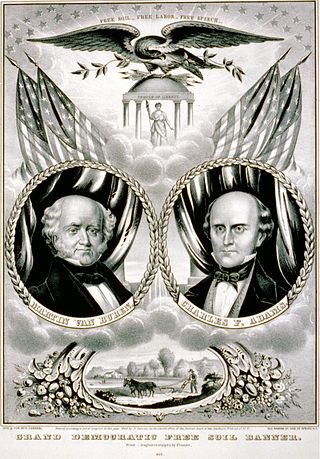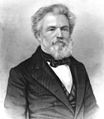
Martin Van Buren was an American lawyer, diplomat, and statesman who served as the eighth president of the United States from 1837 to 1841. A primary founder of the Democratic Party, he served as New York's attorney general, U.S. senator, then briefly as the ninth governor of New York before joining Andrew Jackson's administration as the tenth United States secretary of state, minister to Great Britain, and ultimately the eighth vice president when named Jackson's running mate for the 1832 election. Van Buren won the presidency in 1836, lost re-election in 1840, and failed to win the Democratic nomination in 1844. Later in his life, Van Buren emerged as an elder statesman and an important anti-slavery leader who led the Free Soil Party ticket in the 1848 presidential election.

The 1836 United States presidential election was the 13th quadrennial presidential election, held from Thursday, November 3 to Wednesday, December 7, 1836. In the third consecutive election victory for the Democratic Party, incumbent Vice President Martin Van Buren defeated four candidates fielded by the nascent Whig Party.

The 1848 United States presidential election was the 16th quadrennial presidential election, held on Tuesday, November 7, 1848. In the aftermath of the Mexican–American War, General Zachary Taylor of the Whig Party defeated Senator Lewis Cass of the Democratic Party.

The 1852 United States presidential election was the 17th quadrennial presidential election, held on Tuesday, November 2, 1852. Democrat Franklin Pierce defeated Whig nominee General Winfield Scott. A third party candidate from the Free Soil party, John P. Hale, also ran and came in third place, but got no electoral votes.

The 1856 United States presidential election was the 18th quadrennial presidential election, held on Tuesday, November 4, 1856. In a three-way election, Democrat James Buchanan defeated Republican nominee John C. Frémont and Know Nothing nominee Millard Fillmore. The main issue was the expansion of slavery as facilitated by the Kansas–Nebraska Act of 1854. Buchanan defeated President Franklin Pierce at the 1856 Democratic National Convention for the nomination. Pierce had become widely unpopular in the North because of his support for the pro-slavery faction in the ongoing civil war in territorial Kansas, and Buchanan, a former Secretary of State, had avoided the divisive debates over the Kansas–Nebraska Act by being in Europe as the Ambassador to the United Kingdom.

The Free Soil Party was a short-lived coalition political party in the United States active from 1848 to 1854, when it merged into the Republican Party. The party was largely focused on the single issue of opposing the expansion of slavery into the western territories of the United States.
The Barnburners and Hunkers were the names of two opposing factions of the New York Democratic Party in the mid-19th century. The main issue dividing the two factions was that of slavery, with the Barnburners being the anti-slavery faction. While this division occurred within the context of New York politics, it reflected the national divisions in the United States in the years preceding the American Civil War.

The 1860 Democratic National Conventions were a series of presidential nominating conventions held to nominate the Democratic Party's candidates for president and vice president in the 1860 election. The first convention, held from April 23 to May 3 in Charleston, South Carolina, failed to nominate a ticket, while two subsequent conventions, both held in Baltimore, Maryland in June, nominated two separate presidential tickets.
The 1852 Democratic National Convention was a presidential nominating convention that met from June 1 to June 5 in Baltimore, Maryland. It was held to nominate the Democratic Party's candidates for president and vice president in the 1852 election. The convention selected former Senator Franklin Pierce of New Hampshire for president and Senator William R. King of Alabama for vice president.

Horatio Seymour was an American politician. He served as Governor of New York from 1853 to 1854 and from 1863 to 1864. He was the Democratic Party nominee for president in the 1868 United States presidential election, losing to Republican Ulysses S. Grant.

The 1848 Whig National Convention was a presidential nominating convention held from June 7 to 9 in Philadelphia. It nominated the Whig Party's candidates for president and vice president in the 1848 election. The convention selected General Zachary Taylor of Louisiana for president and former Representative Millard Fillmore of New York for vice president.
The 1856 Democratic National Convention was a presidential nominating convention that met from June 2 to June 6 in Cincinnati, Ohio. It was held to nominate the Democratic Party's candidates for president and vice president in the 1856 election. The convention selected former Secretary of State James Buchanan of Pennsylvania for president and former Representative John C. Breckinridge of Kentucky for vice president.

The 1832 Democratic National Convention was held from May 21 to May 23, 1832, in Baltimore, Maryland. In the first presidential nominating convention ever held by the Democratic Party, incumbent President Andrew Jackson was nominated for a second term, while former Secretary of State Martin Van Buren was nominated for vice president.

The presidency of James K. Polk began on March 4, 1845, when James K. Polk was inaugurated as President of the United States, and ended on March 4, 1849. He was a Democrat, and assumed office after defeating Whig Henry Clay in the 1844 presidential election. Polk left office after one term, fulfilling a campaign pledge he made in 1844, and he was succeeded by Whig Zachary Taylor. A close ally of Andrew Jackson, Polk's presidency reflected his adherence to the ideals of Jacksonian democracy and manifest destiny.

The 1844 Democratic National Convention was a presidential nominating convention held in Baltimore, Maryland from May 27 through 30. The convention nominated former Governor James K. Polk of Tennessee for president and former Senator George M. Dallas of Pennsylvania for vice president.

The 1849 United States Senate election in New York was held on February 6, 1849, by the New York State Legislature to elect a U.S. Senator to represent the State of New York in the United States Senate.

The 1848–49 United States Senate elections were held on various dates in various states. As these U.S. Senate elections were prior to the ratification of the Seventeenth Amendment in 1913, senators were chosen by state legislatures. Senators were elected over a wide range of time throughout 1848 and 1849, and a seat may have been filled months late or remained vacant due to legislative deadlock. In these elections, terms were up for the senators in Class 3.

The 79th New York State Legislature, consisting of the New York State Senate and the New York State Assembly, met from January 1 to April 9, 1856, during the second year of Myron H. Clark's governorship, in Albany.

The 1848 United States elections elected the members of the 31st United States Congress and the 12th president of the United States. The election took place during the Second Party System, nine months after the Treaty of Guadalupe Hidalgo ended the Mexican–American War. With the issue of slavery dividing the nation, the Free Soil Party established itself as the third most powerful party in Congress. California joined the union before the next election, and elected its first Congressional delegation to the 31st Congress. Whigs won the presidency, but Democrats won a plurality in the House and retained control of the Senate.
National conventions of the Free Soil and Liberty parties met in 1847 and 1848 to nominate candidates for president and vice president in advance of the 1848 United States presidential election. The conventions resulted in the creation of the national Free Soil Party, a union of political abolitionists with antislavery Conscience Whigs and Barnburner Democrats to oppose the westward extension of slavery into the U.S. territories. Former President Martin Van Buren was nominated for president by the Free Soil National Convention that met at Buffalo, New York on August 9, 1848; Charles Francis Adams Sr. was nominated for vice president. Van Buren and Adams received 291,409 popular votes in the national election, almost all from the free states; his popularity among northern Democrats was great enough to deny his Democratic rival, Lewis Cass, the crucial state of New York, throwing the state and the election to Whig Zachary Taylor.




































